|





| |
 Wile E. Coyote and Road
Runner
Wile E. Coyote and Road
Runner
Wile E. Coyote (also known simply as "The Coyote") and the Road Runner
are cartoon characters from a series of Looney Tunes and Merrie Melodies
cartoons, created by Chuck Jones in 1949 for Warner Brothers. Chuck Jones based
the films on a Mark Twain book called Roughing It, in which Twain noted that
coyotes are starving and hungry and would chase a roadrunner.
Chuck Jones once said of his most famous protagonist and antagonist that "Wile
E. is my reality, Bugs Bunny is my goal." He originally created the Road Runner
cartoons as a parody of traditional "cat and mouse" cartoons (such as Tom and
Jerry) which were increasingly popular at the time. The cartoons' South-Western
setting also mirrors the setting of the Krazy Kat comics, by George Herriman.
The Road Runner was voiced by Paul Julian, who worked as a background painter
for Friz Freleng's unit.
Premise
The Road Runner shorts are very simple in their premise: the Road Runner, a
flightless cartoon bird (loosely based on a real bird, the Greater Roadrunner),
is chased down the highways of the Southwestern United States by a hungry toon
coyote, named Wile E. Coyote (a pun on "wily coyote"). Despite numerous clever
attempts, the coyote never catches or kills the Road Runner, and all of his
elaborate schemes end up injuring himself in humorous instances of highly
exaggerated cartoon slapstick violence. Southwestern United States by a hungry toon
coyote, named Wile E. Coyote (a pun on "wily coyote"). Despite numerous clever
attempts, the coyote never catches or kills the Road Runner, and all of his
elaborate schemes end up injuring himself in humorous instances of highly
exaggerated cartoon slapstick violence.
There is almost never any "spoken" communication, save the Road Runner's
"beep-beep" (which actually sounds more like "mheep-mheep") and the Road Runner
sticking out his tongue (which sounds like someone patting the opening of a
glass bottle with the palm of their hand), but the two characters do sometimes
communicate by holding up signs to each other, the audience, or the cartoonist
(though both these rules were broken later). Another key element is that while
Wile E. is the aggressor in the series, he and his hopelessly futile efforts are
the focus of the audience's sympathy as well as virtually all of the humor. Wile
E. seems doomed, like Sisyphus, forever to try but never to succeed. The Road
Runner lacks a developed personality and is largely just an
 object,
not a character. object,
not a character.
Wile E. Coyote later appeared in some Bugs Bunny shorts, as well as the Little
Beeper cartoons featured on Tiny Toon Adventures, when he talks. In the Bugs
Bunny shorts in particular, he calls himself a "super genius" (Operation:
Rabbit, 1952; his first speaking appearance, and his first appearance in which
he is called "Wile E. Coyote"); in another cartoon he claims an IQ of 207 (Zip
Zip Hooray!, 1965).
Latin names
Typically at the start of each short, during a chase sequence, the action pauses
to show the audience the apparent Latin (or scientific) names of Road Runner and
Wile E. Coyote, usually emphasising the former's speed and the latter's hunger.
These names change from short to short, as detailed below.
|
Cartoon Title |
Road Runner |
Wile E. Coyote |
|
Actual latin names |
Geococcyx californianus |
Canis latrans |
|
Fast and Furry-ous |
Accelleratti Incredibus |
Carnivorous Vulgaris |
|
Beep, Beep |
Accelerati Incredibilus |
Carnivorous Vulgaris |
|
Going! Going! Gosh! |
Acceleratti Incredibilus |
Carnivorous Vulgaris |
|
Zipping Along |
Velocitus Tremenjus |
Road-Runnerus Digestus |
|
Stop! Look! And Hasten! |
Hot-Roddicus Supersonicus |
Eatibus Anythingus |
|
Ready, Set, Zoom! |
Speedipus Rex |
Famishus-Famishus |
|
Guided Muscle |
Velocitus Delectiblus |
Eatibus Almost Anythingus |
|
Gee Whiz-z-z-z-z-z-z |
Delicius-Delicius |
Eatius Birdius |
|
There They Go-Go-Go! |
Dig-Outius Tid-Bittius |
Famishius Fantasticus |
|
Scrambled Aches |
Tastyus Supersonicus |
Eternalii Famishiis |
|
Zoom and Bored |
Birdibus Zippibus |
Famishus Vulgarus |
|
Whoa, Be Gone |
Birdius High-Ballius |
Famishius Vulgaris Ingeniusi |
|
Hook, Line, and Stinker |
Burnius-Roadibus |
Famishius-Famishius |
|
Hip Hip-Hurry! |
Digoutius-Unbelieveus |
Eatius-Slobbius |
|
Hot Rod and Reel |
Super-Sonicus-Tonicus |
Famishius-Famishius |
|
Wild About Hurry |
Batoutahelius |
Hardheadipus Oedipus |
|
Fastest with The Mostest |
Velocitus Incalculus |
Carnivorous Slobbius |
|
Hopalong Casualty |
Speedipus-Rex |
Hard-Headipus Ravenus |
|
Zip 'n' Snort |
Digoutius-Hot-Rodis |
Evereadii Eatibus |
|
Lickety Splat |
Fastius Tasty-us |
Apetitius Giganticus |
|
Beep Prepared |
Tid-Bittius Velocitus |
Hungrii Flea-Bagius |
|
Zoom at the Top |
Disappearialis Quickius |
Overconfidentii Vulgaris |
|
War and Pieces |
Burn-em Upus Asphaltus |
Caninus Nervous Rex |
|
Freeze Frame |
Semper Food-Ellus |
Grotesques Appetitus |
|
Soup or Sonic |
Ultra-Sonicus Ad Infinitum |
Nemesis Riduclii |
|
Looney Tunes: Back In Action |
(None) |
Desertus-Operativus Imbecilius |
|
The Wizzard of Ow |
Geococcyx californianus |
Canis latrans |
|
By Popular Demand Series - Judge Granny Case 2 |
Birdius Tastius |
Poultrius Devourius |
Scenery
The desert scenery in the first two Road Runner cartoons, Fast and Furry-ous
(1949) and Beep Beep (mid 1952), was designed by Robert Gribbroek and was quite
realistic. In subsequent cartoons the scenery was designed by Maurice Noble and
was far more abstract. Several different styles were used.
In Going! Going! Gosh! (late 1952) through Guided Muscle (late 1955) the scenery
was 'semi-realistic' with an offwhite sky. Gravity-defying rock formations
appeared in Ready, Set, Zoom! (1954). A bright yellow sky made its debut in Gee
Whizzzzz! (early 1956) but was not used consistently until There They Go-Go-Go!,
later in the same year.
Zoom and Bored (late 1957) introduced a major change in background style. Sharp,
top-heavy rock formations became more prominent, and warm colours (yellow,
orange and red) were favoured. Bushes were crescent-shaped. Except for Whoa
Be-Gone (early 1958), whose scenery design harked back to Guided Muscle in
certain aspects, this style of scenery was
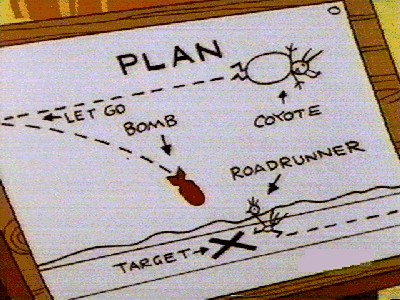 retained
as far as Fastest with the Mostest (early 1960). Hopalong Casualty (mid 1960)
changed the colour scheme, with the sky reverting to blue, and some rocks
becoming off-white, while the bright yellow desert sand colour is retained,
along with 'sharp' style of rock formation pioneered by Zoom and Bored. War and
Pieces ended with abstract Oriental backgrounds. The Format Films cartoons used
a style of scenery which was essentially a paler version of Hopalong Casualty's. retained
as far as Fastest with the Mostest (early 1960). Hopalong Casualty (mid 1960)
changed the colour scheme, with the sky reverting to blue, and some rocks
becoming off-white, while the bright yellow desert sand colour is retained,
along with 'sharp' style of rock formation pioneered by Zoom and Bored. War and
Pieces ended with abstract Oriental backgrounds. The Format Films cartoons used
a style of scenery which was essentially a paler version of Hopalong Casualty's.
The Acme Corporation
Wile E. Coyote often obtains complex and ludicrous devices (Rube Goldberg
machines) from a mail-order company, the fictitious Acme Corporation, which he
hopes will help him catch the Road
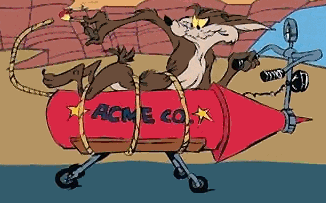 Runner.
The devices invariably backfire in improbable and spectacular ways. The coyote
usually ends up burnt to a crisp, squashed flat, or at the bottom of a ravine.
How the coyote acquires these products without any money is not explained until
the 2003 movie Looney Tunes: Back In Action, in which he is shown to be an
employee of Acme. In a Tiny Toon Adventures episode, Wile makes mention of his
protege Calamity Coyote possessing an unlimited Acme credit card baccount, which
might serve as another possible explanation. Wile E. being a "beta tester" for
Acme has been another suggested explanation. Runner.
The devices invariably backfire in improbable and spectacular ways. The coyote
usually ends up burnt to a crisp, squashed flat, or at the bottom of a ravine.
How the coyote acquires these products without any money is not explained until
the 2003 movie Looney Tunes: Back In Action, in which he is shown to be an
employee of Acme. In a Tiny Toon Adventures episode, Wile makes mention of his
protege Calamity Coyote possessing an unlimited Acme credit card baccount, which
might serve as another possible explanation. Wile E. being a "beta tester" for
Acme has been another suggested explanation.
The company name was likely chosen for its irony (acme means the highest point,
as of achievement or development). The common expansion A Company that Makes
Everything is a backronym.
Among the products by the Acme Corporation are: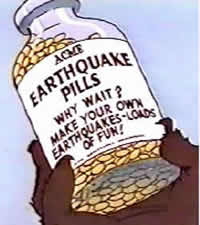
• Acme catapults
• Acme earthquake pills
• Acme rocket sled kits
• Acme portable holes
• Acme Burmese tiger trap kit
• Acme jet-propelled roller skates
• Acme super leg vitamins
• and - a wide selection of explosives: TNT, dynamite, nitroglycerin . . .
As in other cartoons, the Road Runner and the coyote follow the laws of cartoon
physics. For example, the Road Runner has the ability to enter the painted image
of a cave, while the coyote cannot. Sometimes the coyote is allowed to hang in
midair until he realizes that he is about to plummet into a chasm (a process
occasionally referred to elsewhere as Road-Runnering). The coyote can overtake
rocks which fall before he does, and end up being squashed by them.
The Rules
In his book, Chuck Amuck, Chuck Jones explains some of the rules the writers and
artists followed in making the Coyote-Road Runner series:
1. The Road Runner cannot harm the coyote except by going "Beep-beep!"
2. No outside force can harm the coyote—only his own ineptitude or the failure
of the Acme products.
3. The coyote can stop any time—if he were not a fanatic. (Repeat: "A fanatic is
one who redoubles his effort when he has forgotten his aim."–George Santayana;
this quote appears on a promotional poster featuring the duo; with the quote
appearing in Burma Shave-style clips on signs amid the roadrunner's air wake)
4. There may be no dialogue ever, except "beep-beep!" The coyote may, however,
speak to the audience through wooden signs that he holds up.
5. The Road Runner must stay on the road —otherwise, logically, he would not be
called "Road Runner".
6. All action must be confined to the natural environment of the two
characters—the southwest American desert.
7. All materials, tools, weapons, or mechanical conveniences must be obtained
from the Acme Corporation.
8. Whenever possible, gravity should be made the coyote's greatest enemy.
9. The coyote is always more humiliated than harmed by his failures.
There was also a tenth and more unofficial rule:
• The sympathy of the audience must lie with the coyote . .
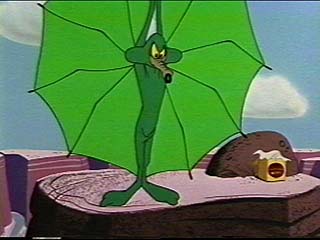 The
rules were followed with rare exceptions. Sometimes the episode is concluded
with Wile E. being flattened by a truck (with the Road Runner grinning from the
rear window). In the 1961 two-reel theatrical short The Adventures of the Road
Runner, Wile E. Coyote actually speaks dialogue as he lectures on how best to
catch the Road Runner. In the 1979 made-for television short Freeze Frame, Wile
E. Coyote chases the Road Runner up into a snowy mountainous region, where most
of the short is spent. In the rare 2000 short Little Go Beep, they explain the
fourth rule by showing a baby Wile E.'s father (voiced by Stan Freberg) telling
him not to speak until he has caught the Road Runner. Chuck Jones directed
Freeze Frame, and advised on Little Go Beep. The
rules were followed with rare exceptions. Sometimes the episode is concluded
with Wile E. being flattened by a truck (with the Road Runner grinning from the
rear window). In the 1961 two-reel theatrical short The Adventures of the Road
Runner, Wile E. Coyote actually speaks dialogue as he lectures on how best to
catch the Road Runner. In the 1979 made-for television short Freeze Frame, Wile
E. Coyote chases the Road Runner up into a snowy mountainous region, where most
of the short is spent. In the rare 2000 short Little Go Beep, they explain the
fourth rule by showing a baby Wile E.'s father (voiced by Stan Freberg) telling
him not to speak until he has caught the Road Runner. Chuck Jones directed
Freeze Frame, and advised on Little Go Beep.
Spin-offs
In another series of Warner Bros. Looney Tunes cartoons, the character design of
Wile E. Coyote was copied and renamed "Ralph Wolf". In this series, Ralph
continually attempts to steal sheep from a flock being guarded by the eternally
vigilant Sam Sheepdog. As with the Road Runner series, Ralph Wolf uses all sorts
of wild inventions and schemes to steal the sheep, but he is continually foiled
by the sheepdog. In a move seen by many as a satirical gag, Ralph Wolf
continually tries to steal the sheep not because he is a fanatic (as Wile E.
Coyote was), but because it is his job. At the end of every cartoon, he and the
sheepdog stop what they were doing, punch a timeclock, exchange pleasantries,
and go home for the day, after which the nightshift team takes over. The most
prominent difference between the coyote and the wolf, aside from their locales,
is that Wile E. has a black nose and Ralph has a red nose.
In the old Looney Tunes and Merrie Melodies comics published by Dell Comics, the
Road Runner was given the name Beep-Beep the Road Runner and had 4 sons and a
wife. The Road Runner family talked in rhyme in the comics. Wile E. was called
Kelsey Coyote in his comic book debut. The Road Runner and Wile E. also make
appearances in the DC Comics Looney Tunes title.
Cultural References
There was a Soviet Union equivalent of the Road Runner series, titled "Ну
погоди! Зайчик-побегайчик" (Pronounciation--Nu pogodi! Zaytchik
pobegaychik!), which in English means "Stop! You running rabbit!". In the
series, a big bad wolf tries unsuccessfully to capture a little hare. The hare
is, however, incredibly annoying. The action is in more of a silent gag movie
style and lacks the Road Runner series' various technological gadgets. Some of
the episodes were animated in black and white.
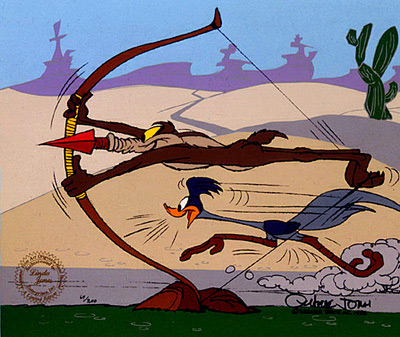 Ice
hockey player Yvan Cournoyer was nicknamed "the Road Runner" due to his blazing
speed on the ice. Ice
hockey player Yvan Cournoyer was nicknamed "the Road Runner" due to his blazing
speed on the ice.
In 2001, the season four episode "Revenging Angel" of sci-fi television series
Farscape featured extended cartoon sequences in which John Crichton and Ka
D'Argo were rendered as Road Runner- and Wile E. Coyote-esque characters. In
these sequences, which were hallucinations experienced by Crichton, D'Argo
purses Crichton using a variety of familiar gags, such as OZME-brand rockets,
explosive "froonium," and fake wormholes painted onto rock walls.
Writer Ian Frazier satirized the Coyote/Acme relationship in his humorous short
story Coyote v. Acme, which appeared in the February 26, 1990 issue of The New
Yorker. The story takes the form of a product liability lawsuit filed by Wile
E.'s attorney against the Acme corporation, detailing the numerous injuries the
company's shoddy goods had caused the hapless coyote. Frazier's piece has been
reproduced on many web sites, often in modified form and often without
attribution.
During the 1988 Yes and No election in Chile, TVN (the national television
network) transmitted the RoadRunner cartoons instead of the election results,
upheld until about 02:00 the next day.
In an episode of Family Guy there is a scene where Peter Griffin's driving
skills comes into question. Brian says "Remember that trip you had to the
south-west?" A Family Guy style
 flashback
occurs with the Road Runner running up the road and Peter running him over.
Peter is then seen in the car and says "Oh God, I think I just hit that ostrich"
and Wile E. Coyote is seen in the passenger seat saying "He's fine, keep going!" flashback
occurs with the Road Runner running up the road and Peter running him over.
Peter is then seen in the car and says "Oh God, I think I just hit that ostrich"
and Wile E. Coyote is seen in the passenger seat saying "He's fine, keep going!"
In a comic series from Neglected Mario Characters (The "NC/SSS Crossover Mach
2," Patrick Van Dusen, in an effort to prove his worthiness to the "Darker Evil"
tries to kill his best friend, the VGWarrior. These attempts are made in a Road
Runner/style hunt, with VGWarrior as the Road Runner and Pat as Wile E. Coyote.
Pat's plans always result in him being humiliated in a similar matter to Wile E.
Coyote. In one scene, he even falls off a cliff, holding up a sign saying
"Somehow I had time to make this sign describing my plight, but not enough time
to save myself from falling into pain."
Commercial Appearances
The Plymouth Road Runner was a performance car produced by the Plymouth division
of Chrysler between 1968 and 1980. An official licensee of Warner Bros. (paying
$50,000 for the privilege), the Road Runner used the image of the cartoon bird
on the sides.
General Motors used the Road Runner on its marketing campaign in 1985 for its
Holden Barina in
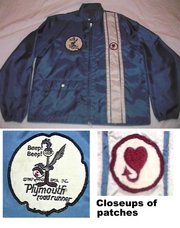 Australia.
Even in 2004, "Beep-beep Barina" is still known as a catch phrase by many
Australians. Australia.
Even in 2004, "Beep-beep Barina" is still known as a catch phrase by many
Australians.
In the late-1990s, Road Runner became the mascot for Time Warner's cable
internet service, also named Road Runner. Balloon sculptor John Cassidy and his
Road Runner balloon animal creation were featured on a commercial for this
service.
In the early-2000s, Road Runner and Wile E. Coyote appeared in a General Motors
car commercial. Wile E. chases the Road Runner while driving the car but the
commercial ends before he is caught.
In 2004, Wile E. appeared (along with Bugs Bunny and Daffy Duck) in an Aflac
commercial, in which he is shown as being a prime candidate for the company's
services. Before he plummets, taking an animated version of the Aflac duck with
him, he holds up a sign reading the company's tagline, "Ask About It At Work."
|